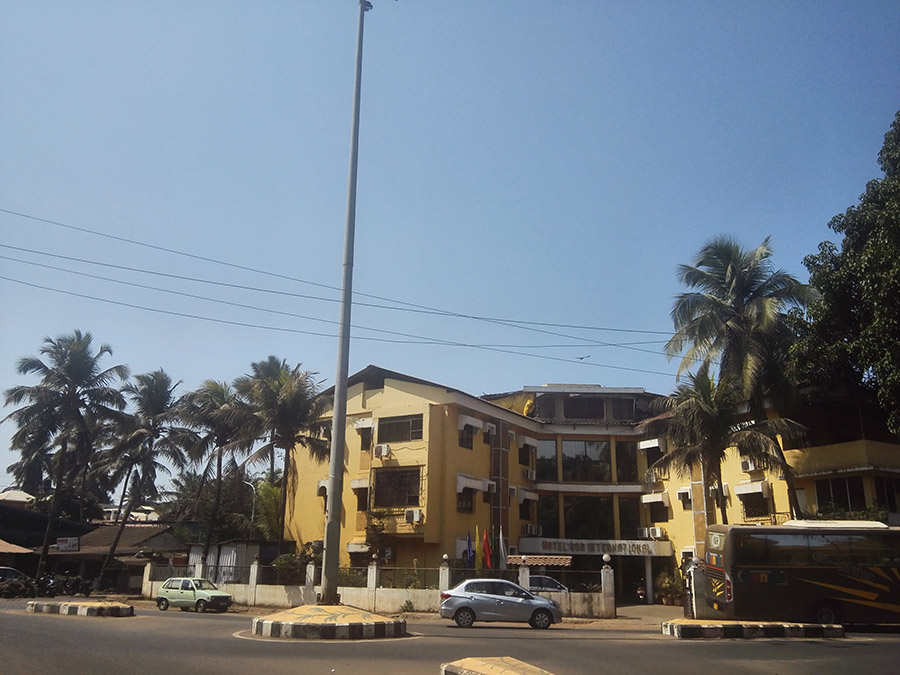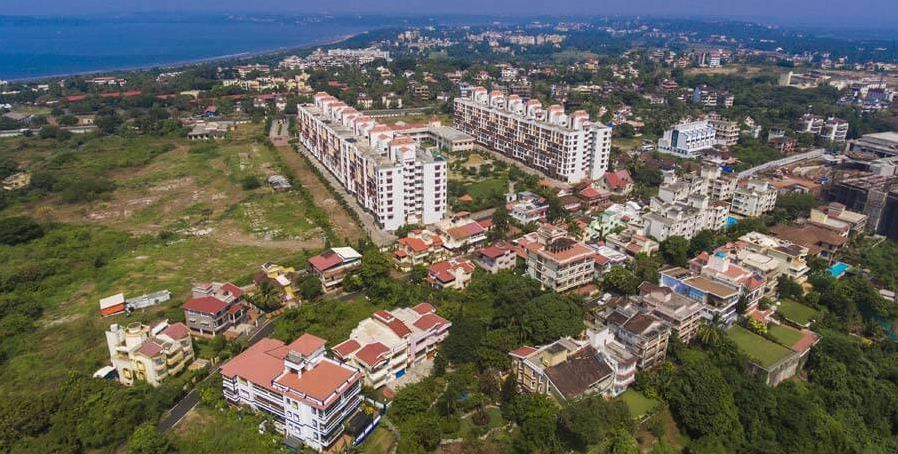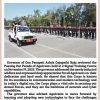Goa is abuzz with excitement as vintage bike and car owners, users, collectors and fans are decking […]

HC NOTICE ON ILLEGAL PANJIM OPD!!LAND SHARKS GRAB 107 PLOTS WITH HUGE FAR!
Cover Story, Feb 23- Mar 01 2019 February 23, 2019SERENITY: The calm and quiet of old colonies will be destroyed by re-development Ala Kamat Royal with the FAR increased to 24 mtrs which roughly corresponds to ten floors as against the present maximum of six floors. No thought has been given to how the takeover by Panjim land sharks will affect the already over-stressed infrastructure in the city. The new ODP is a dumb thing to do for a smart city
PIL BY PROF. EDGAR F RIBERIO
The Goa Bench of the Bombay HC issued notices to various government bodies on the legality of the revised Panjim Outline Development Plan (ODP) which has been challenged in a petition that names the North Goa Planning Development Authority, Commissioner of the Corporation, Chief Town Planner Sidharth Kuncalienker and Michael Lobo. The ODP for Panjim city, which was modified on December 28, 2016 , will convert even serene enclaves like La Campala Colony, St Mary’s Colony, and other older three-storied housing colonies in the Campal – St Inez area into another concrete jungle. As in the case of properties along the Miramar-Dona Paula bypass road, the FAR has been increased to 24 mtrs (residential) and 32 mtrs (commercial) in several parts of Panjim including Campal, St Inez, Adarsh colony, Miramar, Dona Paula, Mala, the Altinho hill slope and the Ribandar hill slope. This will destroy the city which does not have infrastructure to even support the existing population! The petition prays for an order quashing zone changes and as interim relief has asked for a stay on the December 28, 2016 notification. Goan Observer brings you exclusive extracts of the petition…
THIS HUMBLE PETITION OF THE PETITIONER
MOST RESPECTFULLY SHOWS
Particulars of the Cause against which PIL is filed
- This Petition is filed in public interest (PIL) to challenge significant large-scale detrimental changes made in the Outline Development Plan (ODP) for the city of Panaji notified on 28.12.2016 as these are contrary to the statute and contrary to all the norms of planning. The changes are arbitrary, mala fide and not in public interest. They are result of colourable exercise of power. They are solely for private interests and private gain. They are the result of actions of a group of persons in high positions who have knowingly and willingly manipulated the planning procedures for short term gains and reasons best known to them.
- Also, the impugned ODP has been notified in violation of the provisions and processes of the GTCPA, 1974 governing the Regional Plan and ODPs. Further, even if one accepts its legality for the sake of argument, the changes carried out therein are in violation of the Goa Land Development and Building Construction Regulations 2010 (GLDBCR, 2010) which are in force.
- The PIL seeks to show that if the notified ODP changes are allowed to prevail, the original character, identity, natural environment and functioning of the city of Panaji would deteriorate beyond recognition, and the city and its services would eventually collapse (already there is a parking crisis) as the city will be taken over by real estate developers with huge number of commercial and other projects, defeating all the chances of a planned environment for the citizens of the city, a right guaranteed to them under Article 21 of the Constitution of India. The impugned changes made out in the notification dated 28.12.2016 – in contrast to their earlier status in the previous ODP – therefore need to be quashed and set aside in public interest. The PIL focuses only on major changes that will have significant negative environmental impacts, affecting the rights of petitioners guaranteed to them under Article 21 of the Constitution of India.
Facts constituting the cause - The Petitioners state that the area under the Corporation of the City of Panaji consists of 30 wards at present and it has a unique topography, natural environment and identity worth saving for future generations (intergenerational equity). The major part of the city is on the banks of the Mandovi river, starting from Ribandar upto Miramar, and some part from Miramar to Dona Paula is touching the Arabian Sea. Further the area from Dona Paula till Vainguinim touches the jurisdiction of the Village Panchayat of Taleigao and consists of hill and slopes. Besides this, there is the hillock at Altinho and the area towards Fontainhas – Mala which is a low lying area with Rua De Ourem Creek, distinguished by marshy area and mangroves. Considering this topography and natural cover of this planning area under the CCP, it is necessary to ensure these ecological endowments and assets, including Coastal Regulation Zone (CRZ) areas, are safeguarded for future generations as well, together with the historic buildings and conservation areas. In fact, Panaji is a heritage city, demanding conservation on this ground alone.
- The Petitioners state that the Government of Goa enacted the Goa Town and Country Planning Act (GTCP Act) in 1974. The object of the said Act is to provide for establishing the compatible use of land and quantum of built space thereon for the development in both rural and urban areas.
- For this purpose, the Petitioners submit that under the GTCP Act 1974, there is a statutory procedure laid down for carrying out the Development Plan (DP) exercise. First, the TCP Department prepares and notified the statutory Regional Plan for Goa. This is the Master Plan for development of the State in all sectors and regions, including the urban areas or areas declared part of planning areas.
- After this is done, there is first a provision under Section 18 to declare specific areas as “Planning Areas” and under Section 20, constitution of a Planning and Development Authority (PDA) for the area (Chapter IV). The PDA under sections 26-28 (Chapter V) must first prepare the land use map and register. In the context of the Regional Plan (Chapter III), the Outline Development Plan (ODP, for short), is prepared under sections 29-30 and 35-37. This plan (for a 10 or 20 year perspective) specifies proposed land uses in general on a readable map (typically at 1:20,000 scale) for Panaji, specifying the uses allowed/disallowed in each land use category and the applicable Development Control Regulations (DCRs) for each use. Thereafter, the Comprehensive Development Plan (CDP) is prepared under sections 31-32, and again 33-37 without violating the provisions of the Regional Plan (draft/final). The above steps are linked to each other in natural, chronological and logical progression and as supported by relevant research and investigations. Thus, first, the PA is notified, then the PDA, thereafter the Existing Land Use Register is made. Once the register is adopted, the PDA prepares the ODP in consultation with the Local Authority and gets it approved and notified, after soliciting objections/suggestions on the plan prepared. There is time limit of one year for the process. Thereafter, the PDA prepares the CDP which completes the planning exercise. In both instances, the PDA must consult with the local elected authority, in this case, the CCP. From section 35 onwards, both ODP and CDP are referred to in common nomenclature as “Development Plans” (DP).
- Under the scheme of the Act, there is no provision of resting permanently only with the notification of the ODP and not going any further, or subjecting the citizens to newer and newer ODPs without taking the exercise to its logical and statutorily mandated conclusion.
- The Petitioners submit that under section 39 of the said Act, there is indeed a power to make “alteration or additions to the development plan” through fresh surveys and when required but at least once in every 10 years after it comes into operation. This can be done as when necessary or as directed by the Board and the Government, but after consultation with the local authority concerned. If action is contemplated under Section 39, it is necessary to follow all over again the provisions of section 34 to 38 of the said Act, involving public participation. Changes proposed must be in public interest.
- The petitioners state that the Government of Goa constituted the North Goa Planning and Development Authority (NGPDA) for the areas under the then existing Panaji Municipal Council area (which was converted into Corporation of City of Panaji in the year 2002, after enactment of the Corporation of the City of Panaji Act, 2003.)
- Despite the specific provisions (section 255) of the CCP Act 2003 and the 74th Constitutional amendment, the government continued with planning of Panaji city under the GTCP Act, 1974 without giving credence to the provisions of the Constitution Amendment and the CCP Act, 2003 and this is the context in which the present PIL is filed. Petitioners submit there may be specific interests in maintaining land use controls in the Planning Areas through the PDAs. However, these PDAs are nominated bodies and do not accommodate all the elected representatives accountable to the citizens of the area. In any event, most members of the PDAs lack expertise in planned development. Thus the actions carried out under these bodies often lack competence and transparency and are mostly ad hoc. These bodies are not required to heed the voice of citizens through their elected representatives, as occurs under the provisions of the CCP Act. This has resulted in a facilitative influence of real estate developers for land use changes PDAs implying a rank abuse of power, and a persistent violation of statutory provisions, leading to steady deterioration in basic infrastructure and liveability of the city and its heritage and which the petitioners will prove has occurred in the case of the impugned ODP.
- The Petitioners submit that the planning area for Panaji was first notified in the state of Goa in the year 1976. However, the first ODP for Panaji was notified only in the year 2000, even though Panaji is a very small urban area by national standards. It is not disputed that the first ODP (2000) was prepared in the absence of the Existing Land Use and Register. Thereafter, in the year 2006, without proceeding further with the preparation and notification of the Comprehensive Development Plan (CDP) as required by law, the PDA notified a “revised” draft ODP under Section 39 for public objections. It notified the final ODP in 2009 (calling it Panaji ODP 2011). In the case of the second ODP as well, the draft DP was issued without preparation of the Existing Land Use and Register. The Existing Land Use and Register was notified on 22.1.2009 on the same date as the ODP 2009. The Resp.No.1 has been conducting its affairs in violation of the statute with impunity.
The stakeholders and the public at large, have been confused and some even feel harassed by such ad-hoc planning exercises. Planning and planned development of what is still a beautiful city have been the casualty. Petitioners are enclosing herein a table to indicate the very casual manner in which Panjim Planning Areas and its ODP has been set up or withdrawn. The petitioners firmly believe that this chaotic misuse of the relevant laws and prescribed procedures has been intentionally maintained in order to enable the system to make changes in favour of vested interests and lobbies on an as and when basis and with scant respect for the citizens of the city. - In the year 2016, with new political groups in power with fresh appetites, another order to prepare a new draft ODP was issued. The relevant notification under section 39 for the impugned ODP of Panaji 2016/2021 is at Annexure 4. Recent minutes of the Town and Country Board indicate that the ODP is once again going to be changed, on the demands of politicians.
It is time this tendency for absolute arbitrariness is halted once and for all. As per section 19 of the TCPA Act, 1974, when a Planning Area is de-notified or withdrawn, the ODP or DP prepared in connection with the area also lapses. Government must be restrained from arbitrarily using this section outside town planning principles, and as it puts the public to great duress and makes a general mess of planned development as a whole, as it invariably leads to the provision of irretrievable built space to the detriment of the city. - Several statutory provisions govern the carrying out of any changes to a notified Development Plan (DP) being carried out under section 39 of the TCP Act. First, grounds must be available for the government to come to a decision in this connection. After an approval order is obtained from the government under Section 39 (in the instant case, the order is dated 29-04-2016), the DP with its alterations or additions must be submitted (under section 34 to the Government) for its approval. As the facts on record disclose, this procedure was not followed in 2016 though it was followed in the case of ODP 2009. (The gazette notification, when it was actually issued on 6.10.2016, in fact, incorrectly states that approval of the government under section 34 had been obtained.)
- In contravention of this statutory requirement, the Chairperson of the Authority ordered the notice of preparation of the DP (under section 35) without the draft plan, despite being shown the law in this regard by the Member Secretary, as disclosed in the minutes. Copy of the public notice issued is at Annexure 5. Copies of the relevant minutes of the NGPDA (63rd to 65th) are at Annexure 6 colly. Copy of the draft ODP notification is at Annexure 7A and may be compared with the ODP 2009 notice which is at Annexure 7B. The public notice was not issued in the Gazette as required by law, but only in the newspapers. The purpose of this public notice was to actively solicit proposals for land use changes. As per the record, some 287 proposals were received, almost all for enhancement of Floor Area Ratios (FAR) and other lucrative development potential. It is clear that these proposals came largely fromreal estate speculators with no concern for the orderly growth of the capital city.
- It is clear that, at the same meeting, the Respondent Authority regularized the unilateral decision of the Chairperson, despite there being no such power or provision available in the law. Petitioners submit that these are unacceptable actions of the Authority as they specifically violate the requirements of the statute. The haste was resorted to because of the desire to entertain as many changes by vested interests as quickly as possible. Petitioners submit that all these decisions and actions suffer from mala fides and are devoid of public interest or the needs of a planned city.
- As per section 35, a sub-committee comprising a Town Planner and no more than two members of the Authority shall examine proposals for alterations/additions of the ODP. The subcommittee can be appointed only after the completion of the mandatory 2 month period for receipt of objections. The Sub-Committee’s composition was to comprise of a Town Planner and two PDA members. The minutes record, however, that a sub-committee was appointed comprising the BJP MLA of Panaji as Chairperson (who was also a member), 3 PDA members, and the present Member Secretary of the PDA (63rd Minutes). Thus the constitution of the sub-committee exceeded the requirements of the statute. The petitioners do not know the qualifications of the members of the said sub-committee except the fact that the chairman of the committee, the then MLA of Panaji (now former MLA) is an electrical engineer, and Ms. Jennifer Monserrate is also an MLA of Taleigao constituency with no known technical and expert knowledge. The co-opted member Mr. Viresh Nadkarni is a civil engineer. His appointment was made by the government, not the committee, which is also irregular. The Town Planner on the committee was R.K. Pandita, member secretary, NGPDA, kept on deputation beyond regulations governing such deputations, and therefore illegally occupying his chair.
- This subcommittee or its members purportedly commenced inspections of plots in the city and submitted a report to the Authority which was considered on 16.9.2016. It may be noted that as of this date, there were no requests for changes on file from any of the parties. All these requests were, as the record shows, entered into the records en masse only in October 2016. Obviously, all the inspections of these land use changes were carried out informally with interested parties, with the Resp.No.1 as the intermediary.
- In fact, the said sub-committee went ahead and even made recommendations completely beyond its powers. As per the statutory provisions, it had only powers to consider objections made to the draft ODP. It, however, recommended revising the rules of re-development and suggested creation of “Special Settlement Zone with FAR 200 with height of building 24 mts., and Special Commercial Zone with FAR 300 and height of 32 mts.” These facts and these unjustifiable recommendations of the said committee are recorded in the minutes of the 64th meeting. The said committee, if we go by the statute, completely lacked the power to make such recommendations. Worse, these recommendations on changes in regulations were adopted for the purpose of approving drastic changes in the draft ODP notified on 6.10.2016. The Special Settlement and Special Commercial zones were approved without the Goa Land Development and Building Construction Regulations 2010 being amended, notified to the public and even approved by government. The facts speak for themselves. The ODP was notified on 28.12.2016. However, the Special Commercial and Special Settlement zoning regulations were notified (draft) on 17.1.2018 and the final notification only on 27.9.2018.
- The draft ODP which ought to have been approved by the government under Section 34, was notified on 6.10.2016. The revised DP must be in public domain for two months at least. In the present instance, the final date for receipt of objections was December 5, 2016. Only after the receipt of the objections can the Resp.No.1, under section 35(3), appoint a sub-committee, as required, to be appointed. However, the illegal subcommittee set up earlier was allowed to examine all the objections received from the public after the gazette notification of 6.10.2016. It thereafter submitted a second report ostensibly in December 2016. The report has no date. The new changes in land use to accommodate private interests were hurriedly included without question into the DP as notified on 28.12.2016. […].
- The Petitioners submit that the illegal recommendations made by the said committee were accepted without change by the Resp. No.1 and submitted to the Government for approval, as its own. The Resp. No.1 thereafter on 28/12/2016 notified the so-called “alteration/addition” of the ODP by notification dt. 27/12/2016 published in newspapers in Goa on 28/12/2016. This was a wholly new ODP, with new development regulations and zoning, departing radically from the earlier 2009/2011 version. The said notification in fact itself conceded: “The said Outline Development Plan of Panaji 2021 is subject to the provisions of “The Goa Land Development and Building Construction Regulations, 2010” as amended from time to time and subject to final notification of amendment to Regulation 6.A.1 as regards to ‘Special Residential Zone’ and ‘Special Commercial Zone.’” The copy of the said notification is at Annexure 8. The cart was therefore put before the horse, since the ODP approved zoning as per the illegal recommendations of the sub-committee without even the regulations being in force. Petitioners therefore were hard put to file proper objections in the absence of required notified information. For these reasons as well, the notification of the ODP dated 28.12.2016 is bad in law and needs to be quashed and set aside.
- Petitioners have prepared a comprehensive and critical chart of the particular land/survey number (plot) converted under the said ODP from one zone to another along with comments which is annexed to this petition as Annexure 10. The individual plots are identified by specific number on a copy of the notified ODP which is at Annexure 11. Naturally, this work has taken considerable time.
- From these two annexures, it is clear that site conditions have been ignored while assigning new zones to individual plots in the notified plan. It is also clear that the ODP has been prepared ignoring the statutory Master Plan or Regional Plan 2021. This simply cannot be done. Petitioners are providing below significant divergences which cannot be justified legally (Article 14) or from planning point of view:
a) Commercial C1 zone and SPS zones have been assigned to individual properties having steep slopes, indicating that site topography was ignored while assigning new zones to properties. New roads have also been proposed with steep impermissible gradients. This is not permitted as per the parameters informing the Regional Plan. […]
b) Commercial zones assigned to properties with poor access conditions indicate that the widths of existing roads have been ignored in assigning high density zones. This has been done despite orders of this Hon’ble Court. […]
c) Assignment of re-development zones SPS and SPC is not in line with age or condition of the buildings. Even empty plots are zoned in such “re-development” zones. [Refer …] - Impact on the environment and infrastructure ignored:
a) Assignment of re-development zone for buildings having age less than 40-50 years or its structural condition ignores environmental sustainability as it will result in buildings being demolished ahead of completing their economic life. [Refer …]
b) Vacant houses in a city are a huge burden on resources, public infrastructure and energy requirements. Going by the census reports, while the city population is dropping, there is an increase in apartments held by speculators or as second homes. Increase of FAR and building heights do not guarantee occupancy and the introduction of new zones has to be linked to guaranteeing high occupancies. [Refer …]
c) Random distribution of high density zones render assessment and implementation of upgraded public utilities to these areas highly impractical. This is of serious consequence with regard to fire safety and allied services.
d) Traffic congestion, already a major curse of the city, has been ignored in view of the new densities now being permitted. - Reduction in heritage boundaries
[…] - Reduction in the A2 (Natural reserve / Orchards) zone.
a) Changes in A2 boundaries in Ribandar and Altinho slopes indicate reduction in Natural reserve/Orchard zones. These lands are sloping with steep gradients and have been changed into commercial C1 zones.
[Refer …] - Reduction in the Recreational zone.
a) High density zones have been assigned for the residential neighbourhoods of Miramar with simultaneous reduction of recreational zone near Indoor Stadium in favour of a cable car project. Such actions severely skew the ratio of public space to residential population. The priorities of the ODP 2021 and the NGPDA clearly do not favour an improved quality of life for the existing neighbourhoods and citizens.
[Refer …]. - Random insertions of high density and high rise structures (10 floors) in low rise residential neighbourhoods are in complete contrast to the neighbourhood character and scale.
Reference – Notified ODP Plan 2021 for residential plotted colonies of Lake View, La Campala, St. Mary, Caculo Colony, Nina Pinto colony, Tonca – behind Hotel Goa International, Caranzalem plotted layouts etc.
a) Carrying capacities of internal roads providing access to high density zones ignored, road details not provided in a number of instances. [Refer …]
b) Minimum plot size necessary for high rise development ignored. [Refer …]
c) Ratio of neighbourhood schools to residential population skewed with the rise in permissible densities.
d) Reduction of Natural reserve/Orchard zone and Recreational zone. [Refer …] - A detailed study of the ODP Panaji 2021 and a comparison with the ODP 2011 indicates an arbitrary and flawed rationale has been utilized primarily to increase Building Density/utilization intensity of random individual plots. In fact, grounds that were used to deny land use change requests in ODP 2011 were now openly used to justify changes in ODP 2021. Petitioners submit that current addition/alterations to the ODP 2021 are completely contrary to the planning principles/policies originally applied to ODP 2011. The report of the committee on the Objections/Representations received on the ODP of Panaji 2011, notified first time report and second time report under section 35 of TCP Act clearly indicate to what extent the impugned ODP diverts from planning.
- The relevant rejections of suggestions made by the public for the 2011 ODP are summarized briefly below:
1) Reject change to higher density settlement zones for residential plots in a sub-division layout
2) Reject change to commercial zones in sub-division layouts.
3) Reject change in zone to commercial to promote residential development in the area (C2 to C1, S2 to C2/C1, S1 to C2, S2 to C1).
4) Rejection as the change in zone will drastically change the character of the area (S2 to C1)
5) Rejection as the change of zone will lead to traffic congestions.
6) Rejection on the basis that change of recreation zone will deprive the city of recreational area.
7) Rejection on the basis that property is sloping in nature.
8) Rejection on the basis of saturation of commercial activity at busy junctions.
No grounds have been offered for departing from these planning principles adopted by the Resp.No.1 for the ODP of 2011. Table showing the U-turns adopted by the Resp. No.1 is at Annexure 14. - As will be seen from the two sub-committee reports, the said committee has not considered any aspect related to planning, required infrastructure and environment impact. Nor has the committee considered the eco-zones of the RPG 21, while accepting suggestions for changes of the land use of individual plots. The ODP cannot be prepared de hors the Master Plan of the State. Thus the entire exercise was illegal and mala fide, without any redeeming features and completely contrary to the provisions and intent of the GTCP Act, ’74 and outside the participatory directives of the Constitutional Amendment and the consultative processes required with the CCP. Petitioners are entitled to a planned environment which is deemed to be an integral part of Article 21 of the Constitution of India. The impugned ODP is an ODP of politicians and real estate speculators, and is an example of exactly the kind of planning that the TCP Act is supposed to eschew.
- As stated earlier, the appointment of the Sub-Committee was itself illegal, as first, the DP had not been notified as required, after obtaining approval from government as required under Section 34. Further, the sub-committee was formed by the Resp. No.1 on 16.06.2016. As expected, the Chairperson of the Sub-Committee misused the position to solicit proposals for substantial number of private changes to the re-zoning of individual plots for purposes best known to him. For these reasons, many of the approved changes are clearly mala fide and liable to be quashed and set aside and thus reverted to their original land use as provided in the 2011 DP as they are decidedly against public interest, result of colourable exercise of power and contrary to planned development. No sub-committee was constituted, as required, two months after the notification of the draft DP in the gazette on 6.10.2016, though a Sub-Committee was appointed on 6.12.2016 in connection with the objections received for the Mapusa ODP. The minutes of the Resp. No.1, in fact, record setting up of a subcommittee for Panaji ODP. However, the actual reference in the minutes is to the Mapusa ODP. Under the RTI Act, petitioners have not been able to obtain any order issued for constitution of a subcommittee for the Panaji ODP except the one that was set up prior to issue of the draft DP on 6.10.2016.
- The statutory violations recounted above were followed by other statutory violations. Any change in the ODP in terms of alteration should be as per studies or surveys as required as per section 39 of the TCPA Act, under which the order was issued. However, the PDA took the unusual decision of vacating this requirement because it concluded it would be “cumbersome exercise and time consuming.” (64th Minutes) It therefore decided to assume that the objections/suggestions it received from the public would substitute for the survey to be conducted by the authority. This decision alone clearly establishes that the changes in land use have been made by the PDA not on the basis of scientific or rational zoning requirements, including survey, analysis, or needs of the city but only on the basis of individual requests, mostly solicited. For this reason as well, the changes made are result of colourable exercise of power, against public interest, violate Article 14 and need to be quashed and set aside. If planning is done in this unacceptable manner, there is no need for any ODP or DP or Regional Plan or for that matter even a Town and Country Planning Department.
- The Petitioners submit that the ODP 2021 which is notified is not a plan made independently and objectively by the Authority on the basis of proper survey conducted by it or its own study, considering present and future requirements of the city, but the same is made at the instance of private parties to gain personal benefits by increasing their FAR or to convert ad hoc residential areas into commercial areas and to favour existing commercial and settlement areas with higher densities at the expense of the general public that is residing in the city. It is absurd that the sub-committee or its members or co-opted members could be given such wide powers to survey and approve such vast changes (including proposing new regulations) in the manner that was done. From the record, in fact, one sees that the visits were conducted mostly by the co-opted engineer with help from the PDA assistant, yet claims are made in the report that the sub-committee conducted hearings and heard the persons concerned. Petitioners are annexing a table to show that the subcommittee visited all plots for its first report during the month of July 2016 on the basis of proposals made in October 2016! For its second report, all proposals were received either one or two days prior to the visit of the subcommittee, or on the same date as inspection took place or immediately thereafter. […]. As can be seen, the inspections were speedily done. The entire exercise is a fraud and an afterthought. The idea of zoning as is known to planners is wholly jettisoned and violates the Act. Individual plots are treated as “zones”. Petitioners submit this is not at all permitted by planning norms and by judicial pronouncements in planning matters. PIL filed on this specific aspect (PIL WP No.44/2018) has already been admitted for hearing by this Hon’ble Court. Application for interim stay is being considered.
[…]
Grounds: - The Petitioners submit that whereas the earlier two ODPs did not seriously compromise the city’s heritage and environmental assets, the impugned ODP is of a qualitatively different kind and constitutes an extreme perversion in terms of planning exercises required by the GTCP Act, ‘74 and rules. The said ODP is illegal and liable to be quashed and set aside on the following three major grounds, among others:
A) Violation of the steps and procedures governing the scheme of planning laid out in the GTCP Act, ‘74.
B) Violation of the requirements for preparation of an ODP and consideration of objections thereto (surveys, etc).
C) Land use and development proposals in the impugned ODP that are self-contradictory, and approved in violation of the basic tenets and norms of planning.
[…] - The Petitioners submit that the ODP Panaji 2021 is prepared contrary to and in violation of provisions of Section 39 read with Section 34 to 37 of the GTCP Act, ‘74. Provisions of “The Goa (Regulation of Land Development and Building Construction) Act 2008 and the Goa Land Development and Building Construction Regulation 2010” as well as Article 243 of the Constitution of India and Corporation of City of Panaji Act, 2002. The Petitioners submit that under Section 31 of the Town and Country Planning Act it was necessary to prepare Comprehensive Development Plan (CDP) within 3 years of preparation of Outline Development Plan. However, after notification dated 22/1/2009, no such Comprehensive Development Plan has been prepared.
- The Petitioners submit that, in conclusion, the draft ODP 2021 for the City of Panjim has been hurriedly prepared and is wholly contaminated with mala fide actions and gross manipulations. As such, it will lead to disaster if implemented, in its current form and as a precedent. Apparently the elections for Legislative Assembly Goa were about to be declared during this time and just before few days of declaration of elections scheduled on 4/2/2017, the ODP 2021 was notified. The Petitioners had made representation on 5th and 6th December 2016 and Resp. no. 3 had fixed a hearing on 8th December 2016, however, till date none of the concerns were considered.
- Hence the Petitioners have no option but to approach this Hon’ble Court as the Resp. nos. 1-4 have not considered the provisions of law and there is no response from the said respondents on the Applicants’ representation. Under such circumstances, immediate intervention of this Hon’ble Court is required and legality of the ODP Panaji 2021 and its preparation are required to be examined by this Hon’ble Court otherwise public interest shall suffer and the built environment of Panjim city is forever doomed.
- The Petitioners submit that the Resp. nos. 1-5 are not entitled to act on the basis of the impugned ODP and such exercise is illegal.
- The petitioners submit that in spite of writ Petition no. 157/2017 filed by the then Mayor of Resp. no. 2 and its corporators challenging the said ODP Panaji 2021 before the Hon’ble High Court, the Resp. no. 1 and the commissioner of the Resp. no. 2 are issuing permissions and therefore the said respondents are liable to be restrained from issuing permissions based on the said ODP Panaji 2021 pending the hearing of this petition and all the permissions granted are required to be stayed.
- Hence the Resp. nos. 1 to 5 are required to be restrained from in any manner proceeding any further with the implementation of the said ODP Panaji 2021. Hence the petitioners are filing this petition before this Hon’ble Court for the reliefs set out in the prayer clause hereunder.

















